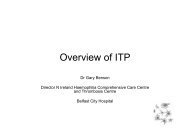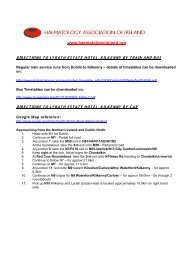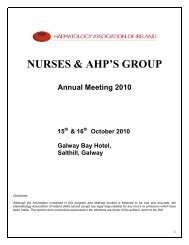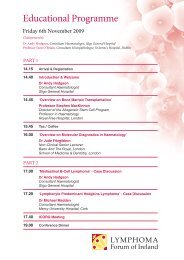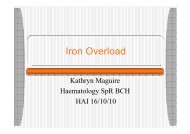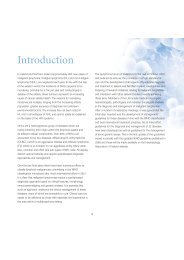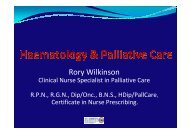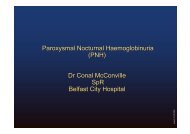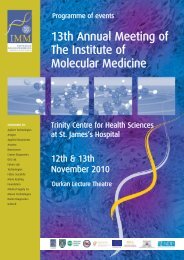Guidelines on Diagnosis and Treatment of Malignant Lymphomas
Guidelines on Diagnosis and Treatment of Malignant Lymphomas
Guidelines on Diagnosis and Treatment of Malignant Lymphomas
You also want an ePaper? Increase the reach of your titles
YUMPU automatically turns print PDFs into web optimized ePapers that Google loves.
Anaplastic Large<br />
Cell Lymphoma<br />
Definiti<strong>on</strong> <strong>and</strong> Incidence<br />
ALCL-ALK+ve is a T cell lymphoma characterised by<br />
translocati<strong>on</strong> involving the ALK gene, expressi<strong>on</strong> <strong>of</strong> the ALK<br />
protein <strong>and</strong> CD30. Primary systemic ALCL must be distinguished<br />
from Anaplastic large cell lymphoma (ALK negative), primary<br />
cutaneous ALCL <strong>and</strong> other T <strong>and</strong> B cell lymphomas with<br />
anaplastic morphology <strong>and</strong>/or expressi<strong>on</strong> <strong>of</strong> CD30.<br />
ALCL-ALK-ve is a provisi<strong>on</strong>al entity defined as a CD30+ T cell<br />
neoplasm, morphologically indistinguishable from ALCL, ALK+,<br />
but lacking ALK protein expressi<strong>on</strong>.<br />
ALCL accounts for about 3% <strong>of</strong> adult NHLs <strong>and</strong> 10-30% <strong>of</strong><br />
childhood lymphomas. It has an incidence <strong>of</strong> 0.24 new<br />
cases/100,000 populati<strong>on</strong>/year. ALK+ve ALCL is most frequent in<br />
the first 3 decades <strong>of</strong> life <strong>and</strong> has a M:F ratio <strong>of</strong> 6:1. ALK –ve<br />
ALCL occurs in older patients with a slight female predominance.<br />
ICD-O code 9714/3<br />
Clinical Presentati<strong>on</strong><br />
ALCL frequently involves both lymph nodes <strong>and</strong> extra-nodal sites<br />
including the skin (21%), b<strong>on</strong>e (17%), s<strong>of</strong>t tissue (17%), lung<br />
(11%) <strong>and</strong> liver (8%). Involvement <strong>of</strong> the CNS <strong>and</strong><br />
gastrointestinal tract is rare. Marrow involvement occurs in 10%<br />
<strong>of</strong> cases but this increases to 30% if immunohistochemistry for<br />
CD30, EMA <strong>and</strong> ALK is used.<br />
70% <strong>of</strong> patients present with stage III or IV disease <strong>and</strong> most<br />
have B symptoms, particularly high fevers.<br />
Pathology<br />
Pathological appearance is variable. Lymph node/tissue<br />
architecture may be partly effaced <strong>and</strong> the disease typically grows<br />
within node sinuses. Morphology is variable, ranging from small<br />
cell neoplasms to cases with large anaplastic nuclei. All cases<br />
c<strong>on</strong>tain cells with eccentric reniform nuclei known as “hallmark<br />
cells” although the proporti<strong>on</strong> <strong>of</strong> these cells present is variable.<br />
Morphologic variants include lympho-histiocytic, small cell, <strong>and</strong><br />
Hodgkin-like patterns.<br />
Immunophenotype<br />
Cells are CD30+ve with cell membrane <strong>and</strong> Golgi regi<strong>on</strong> pattern.<br />
Most cases are EMA positive. CD2, CD4, CD5 are positive in<br />
70% <strong>of</strong> cases. Most cases express T cytotoxic associated<br />
antigens including TIA-1, perforin <strong>and</strong> granzyme B. CD3, CD8,<br />
CD15 are negative in most cases.<br />
ALK protein is positive, most cases dem<strong>on</strong>strating both nuclear<br />
<strong>and</strong> cytoplasmic expressi<strong>on</strong>. Variant expressi<strong>on</strong> patterns,<br />
cytoplasmic, nuclear <strong>and</strong> membranous, exist.<br />
Genetics<br />
90% <strong>of</strong> cases show cl<strong>on</strong>al T cell receptor gene rearrangements.<br />
Various ALK translocati<strong>on</strong>s are described: the most comm<strong>on</strong>,<br />
accounting for >80% <strong>of</strong> cases, is the t(2;5)(p23;p35)<br />
translocati<strong>on</strong> involving the ALK gene <strong>and</strong> the nucleophosmin<br />
gene <strong>on</strong> 5q25 resulting in nuclear <strong>and</strong> cytoplasmic ALK protein<br />
expressi<strong>on</strong>. Variant translocati<strong>on</strong>s involving ALK <strong>and</strong> partner<br />
genes <strong>on</strong> chromosomes 1,2,3,17,19,22,X occur <strong>and</strong> are<br />
associated with variable protein expressi<strong>on</strong> patterns.<br />
Staging<br />
As for DLBCL.<br />
57



